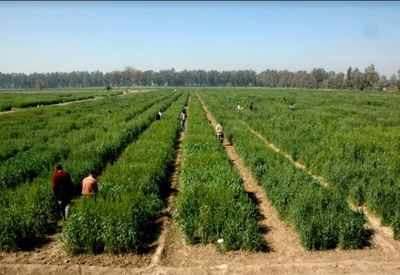- News
- India News
- Food security: Understanding wheat like never before
Trending
This story is from November 26, 2020
Food security: Understanding wheat like never before

After a record-breaking study of more than 20,000 different lines/types of wheat to identify types that are more efficient against some specific diseases and climate change, a group of researchers led by Prof KC Bansal has found 50 such types of the crop.
“This was a unique initiative (recorded in Limca Book of Records) where about 22,000 types of wheat were studied at a single site for the first time ever in the history of National Bureau of Plant Genetic Resources (NBPGR),” Bansal, member, board of directors, Global Plant Council and former director of NBPGR, told TOI.
Pointing out how the national wheat improvement programme contributed significantly toward achieving food security since the advent of the green revolution of the 1960s, Bansal, however, said, there was a need for sustainable wheat production in the era of climate change by developing high yielding thermo-tolerant varieties with durable disease resistance, and with the capacity to produce more with less of water and fertilizers.

The team led by him took the initiative in 2011, and it took them five years to complete the study (2016), and another four years to analyse the massive datasets the study created.
Now, two research papers will appear in the journal - Crop Science (2020), while one of the papers has appeared on the cover of the journal that is being especially brought out this year as the International Year of Plant Health, United Nations.
Speaking about the major outcomes of the study, Bansal said they have identified promising lines of wheat resistant to different rusts (leaf rust, stem rust and stripe rust) and spot blotch diseases – 45 lines out of about 20,000.
“We’ve also identified sources of resistance to powdery mildew disease – 52 lines out of about 20,000 wheat lines; 42 highly thermo-tolerant lines out of 20,000 for developing much needed high temperature tolerant wheat varieties,” he said.
“...The above identified lines of wheat is a ready source available for developing climate resilient wheat varieties by breeders and biotechnologists,” he added.
“This was a unique initiative (recorded in Limca Book of Records) where about 22,000 types of wheat were studied at a single site for the first time ever in the history of National Bureau of Plant Genetic Resources (NBPGR),” Bansal, member, board of directors, Global Plant Council and former director of NBPGR, told TOI.
Pointing out how the national wheat improvement programme contributed significantly toward achieving food security since the advent of the green revolution of the 1960s, Bansal, however, said, there was a need for sustainable wheat production in the era of climate change by developing high yielding thermo-tolerant varieties with durable disease resistance, and with the capacity to produce more with less of water and fertilizers.

“To meet these challenges, it was desired to evaluate all lines of wheat germplasm conserved in the National Gene Bank at NBPGR (ICAR), Pusa to identify promising lines for use by breeders. But this was a gigantic task and never attempted before involving all about 22,000 wheat lines stored in the Genebank for the last about 45 years,” he said.
The team led by him took the initiative in 2011, and it took them five years to complete the study (2016), and another four years to analyse the massive datasets the study created.
Now, two research papers will appear in the journal - Crop Science (2020), while one of the papers has appeared on the cover of the journal that is being especially brought out this year as the International Year of Plant Health, United Nations.
Speaking about the major outcomes of the study, Bansal said they have identified promising lines of wheat resistant to different rusts (leaf rust, stem rust and stripe rust) and spot blotch diseases – 45 lines out of about 20,000.
“We’ve also identified sources of resistance to powdery mildew disease – 52 lines out of about 20,000 wheat lines; 42 highly thermo-tolerant lines out of 20,000 for developing much needed high temperature tolerant wheat varieties,” he said.
“...The above identified lines of wheat is a ready source available for developing climate resilient wheat varieties by breeders and biotechnologists,” he added.
End of Article
FOLLOW US ON SOCIAL MEDIA










